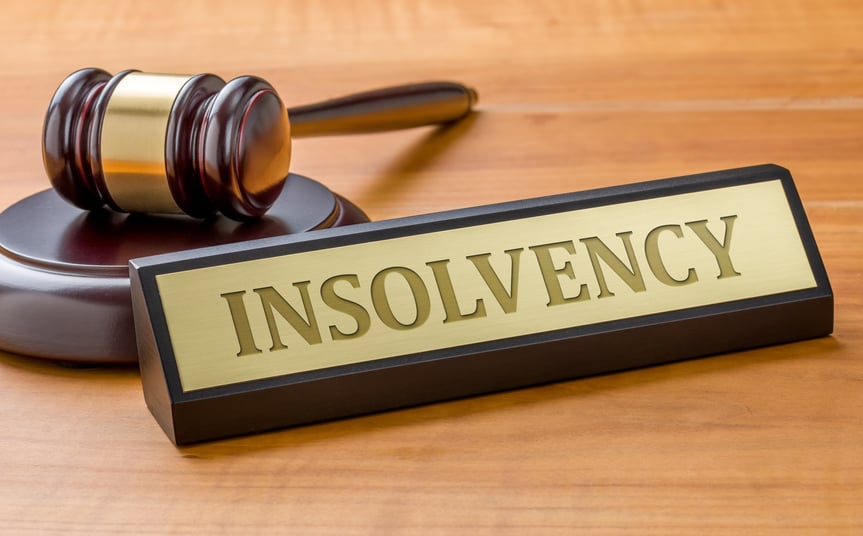The difference between insolvency and bankruptcy
Insolvency occurs when a company or individual is unable to pay its debts as they face financial difficulty. There are a number of insolvency procedures available so that the debtor (the company or individual facing the debt) can manage the situation well.
You should seek expert advice to help you deal with insolvency. We understand the difficulties faced by those who are faced with insolvency – there’s a lot of jargon, information, and policies out there when it comes with insolvency management. That’s why, in this post, we highlight the six different types of insolvency, and explain exactly what each one means, to help you better understand the various proceedings.
Bankruptcy
If an individual cannot pay back its debts, one of their options might be to apply for bankruptcy. Bankruptcy only applies to individuals, sole traders or partnerships and the whole bankruptcy period lasts around 12 months, after which the debtor (the individual who owes the money) is ‘discharged’.
A creditor (the person who is owed money) can also apply for bankruptcy, if the individual owes at least £5,000. If the debtor cannot pay it back in monetary form, all assets owned by the debtor may be taken away and sold to pay off the debt.
This type of insolvency is legally binding and should not be considered an easy way out of financial trouble. That’s why we advise contacting a specialised bankruptcy team to assess whether alternatives could be better suited to your circumstances. Bankruptcy could be the best option for those who owe more than £15,000, and are unable to meet the repayments.
To apply for bankruptcy, an individual will need to pay a fee of £680, which is not refunded when the order is made. It is essential to ensure that all of the details on the bankruptcy application are truthful; false statements are a criminal offence. You can see the advantages and disadvantages of bankruptcy here.

Individual Voluntary Arrangement (IVA)
An IVA is where an individual arranges their debts with creditors as an alternative to bankruptcy. This will be presented to the creditors and, if it is accepted, the agreement will become legally binding. Entering an IVA will allow an individual to continue trading, which makes it more attractive than applying for bankruptcy. This type of insolvency could be the right one for those with regular household incomes. There is no minimum unsecured debts of someone entering an IVA, however, it is often for debts of £15,000, or more.
The individual will only pay what they can afford to for a certain amount of time, and, once the IVA is over, any remaining debt is written off. Setting up an IVA is straightforward and, with the help of our expert team, could be done in as little as six weeks. So, if you feel as though this is the right solution for you, just get in touch.
Company Voluntary Arrangement (CVA)
Another different type of insolvency is a Company Voluntary Arrangement. This is a rescue and restructuring option which can help ensure the survival of a company while the directors remain in control of the business. Similarly to an IVA, which is for individuals and sole traders, a CVA is a formal arrangement between a company and its creditors, where it is agreed that the debtors pay the owed amount in full or in part over time.
If the proposal to the creditors is accepted, the arrangement will be legally binding. Once the CVA period comes to an end, any outstanding debts are written off. In order to enter a CVA, your business must be able to return to profitability and have a viable future. If you are prepared to fight for your business’s survival, a CVA could be the best option. Contact us for expert help and guidance if you feel this type of insolvency is for you.

Compulsory Liquidation
Compulsory liquidation happens when a company is ordered by a court to be wound-up. A creditor normally presents a petition to a court, which states that they are owed money by the company, who cannot pay these debts.
If a company owes more than £750, and can be proved that they cannot pay this back, then they are regarded as unable to pay by a creditor. If this petition presented to the court is successful, a copy of the winding-up order will be placed on the company’s public record.
The Official Receiver becomes liquidator when the order is made, and they must realise the company’s assets, pay the fees, and pay the creditors as much as the company is able.
When the wind-up of the company is complete, the company will be dissolved 3 months after the notice was registered at Companies House.
Creditors’ Voluntary Liquidation (CVL)
This is a quick and powerful way to close a company while dealing with the process legally and properly. If a company faces insolvency, it is the duty of a director to cease trading and seek professional advice about the options available to them. If this company has no viable future, and cannot return to profitability, then a CVL may be the right way to go.
If carried out correctly and at the earliest possible time, a director may not have to pay to liquidate a limited company. Insolvency in this case can often be paid for through company assets.
Unlike compulsory liquidation, shareholders pass a resolution to wind the company up without the need for a court order. Shareholders will vote to appoint a liquidator, who is to pay all the fees associated with the liquidation process. A liquidator must also pay the creditors as much as the company’s funds can allow.
A meeting of creditors must be held within 14 days of the shareholders’ meeting. During this meeting, creditors will also vote to appoint a liquidator. Should the creditors’ choice of liquidator differ from that of the shareholders’, the creditors’ choice prevails. This is why this type of insolvency is called Creditors’ Voluntary Liquidation.

Administration
The final type of insolvency is administration. This applies to limited companies, with the aim of getting a business out of financial trouble and back trading again – if possible. The court, directors, or bank may appoint a licensed insolvency practitioner as administrator, which places a moratorium around the company while stopping legal actions.
If the company is unable to be rescued from financial trouble, the administrator will attempt to get a better result for the creditors than they would if the company was wound up. If this cannot be done, then the administrator will need to sell the company’s assets in order to pay back the debts to the creditor.
This type of insolvency can be very powerful where the company has a very aggressive creditor, and needs to protect itself from them while a rescue plan is worked out. For more information, and to get expert help with administration, contact our professional team.
How we can help you
If you would like more information about the different types of insolvency, and how we could help you and/or your company, we can provide you with a free initial consultation during which we will assess your situation and provide our recommendations. Get peace of mind and request a free consultation today.

